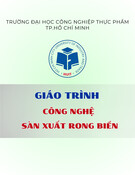
J. Korean Soc. Appl. Biol. Chem.
53
(1), 71-77 (2010)
Article
Optimization of the Manufacturing Process for Black Ginseng
Young-Ju Ban
1
, Byung-Wook Yang
2
, Moo-Yeol Baik
1
, Young-Tae Hahm
2
, and Byung-Yong Kim
1
*
1
Department of Food Science & Biotechnology, Institute of Life Science & Resources, Kyung Hee University,
Yongin 449-701, Republic of Korea
2
Department of Biotechnology, Chung-Ang University, Anseong 456-756, Republic of Korea
Received October 30, 2009; Accepted December 22, 2009
Black ginseng is derived from a repeated steaming/drying process; however, the black ginseng
manufacturing process is not well established. To determine the steaming and drying optimum
conditions for producing high levels of biologically active substances such as acidic
polysaccharides, ginsenoside Rg3, and polyphenols and low levels of benzopyrene, r esponse surface
methodology was used with temperature and time as independent variables. As steaming
temperature/time increased, acid polysaccharide, polyphenol, and benzopyrene content increased;
ginsenoside Rg3 levels increased with steaming time at temperatures
≥
100
o
C. As drying
temperature/time increased, ginsenoside Rg3, benzopyrene, and acidic polysaccharide content also
increased. These subs tances sh owed a nonli near canonical for m, whereas the phenolic componen t
showed a linear canonical form. Optimum conditions were determined to be steaming at 113.04
o
C
for 18 h and dryin g at 100
o
C for 8.03 h, resulting in 0.75 mg/g ginsenosid e Rg3, 13.72 mg% ac idic
polysaccharide, 0.26 ppb benzopyrene, and 3.24 mg% polyphenol.
Key words:
acidic polysaccharide, benzopyrene, black ginseng, ginsenoside Rg3, optimization
process, response surface methodology
Ginseng (
Panax ginseng
C. A. Meyer) is a perennial
plant that belongs to t he Araliac eae fam ily, genus Panax,
and has been widely used in Asian medicine for
thousands of years [Park
et al
., 2003]. Because saponin is
a typical ingredient among other physiological active
ingredients in ginseng, it can be used as an indicator for
judging the quality of ginseng and ginseng-functional
products [Choi
et al
., 1989; Jeon
et al
., 1991]. Acidic
polysaccharide as a nonsa ponin ingredient has antihyper-
glycemic effects and regulates immune function [Konno
et al
., 1984; Gao
et al
., 1991; Chang
et al
., 2007]. The
phenol ingredient includes an active aging-control substance
and shows antioxidant effects on lipid oxidation [We e
et
al
., 1998].
Red ginseng is obtained through a proces s of steaming
and drying from white ginseng. During this process, the
ingredients of fresh ginseng are changed, and new
physiological ingredients, which are not present in fresh
ginseng, are generated, and their content increased.
Recently, a black ginseng product produced by a new
process that uses a principle derived from Chinese herbal
medicine called “kujeungkupo” (nine times steaming,
nine times drying) is being developed [Roh and Park,
2008]. Black ginse ng contains mor e ginsenoside Rg3, an
anticancer medicine, than red ginseng [Han
et al
., 2005].
However, a standard process of kujeungkupo for the
production of black ginseng has not yet bee n e sta blis hed,
and this ad-hoc process has been occasionally found to
produce excessive benzopyrene which has recently been
classified as a carcinogen.
Therefore, the aim of this study was to standardize and
optimize the s teaming and drying manufact uring process
for manufacturing the black ginseng using response
surface methodology in order to reduce the content of
benzopyrene and enhance the content of acidic poly-
saccharide, ginsenoside Rg3, and polyphenol.
Materials and Methods
Materials.
The dried ginseng used in this experiment
was a 4-year-old certified white ginseng that had been
produced in Geumsan district in Korea. Acetonitrile and
isopropyl alcohol were purchased from JT Baker
(Phillipsburg, NJ) for use in extraction and f ractionation.
*Corresponding author
Phone: +82-31-201-2627; Fax: +82-31-202-0540
E-mail: bykim@khu.ac.kr
doi:10.3839/jksabc.2010.012

72 Young-Ju Ban
et al.
Carbaz ole (Sig ma, S teinhei m, Germany ), Folin -Ciocal teu
phenol reagent (Sigma, St. Louis, MO), and sodium
carbonate (Yakuri Pure Chemical Co. Ltd., Kyoto, Japan)
were used as reage nts.
Production and extraction of black ginseng.
Ten-
gram batches of white ginseng were steamed using a
steaming machine (T-30, Jinghong Tech., Ilsan, Korea) at
different temperatures (60, 80, and 100
o
C) and times (6,
12, and 18 h). The drying process wa s pe rformed using a
drying machine (HK-D0135, Hankook Jonghabgigi Co.,
Hwasung, Korea) at different temperatures (60, 80, and
100
o
C) and times (3, 6, and 9 h). All experiments were
repeated three times. The resultant black ginseng was
homogenized with a homogenator (ULTRA-TURRAX T-
25, IKA-Labortechnik, Staufen, Germany) and extracted
with 80% methanol (100 mL). Finally, the black ginseng
extract was filtered and concentrated to a constant volume
of 50 mL.
Extraction of crude saponin.
Crude saponin content
was determ ined according to the Korean Food Code and
was subsequently used to analyze ginsenoside. Crude
saponin was concentrated by centrifugation,
and the
sample was extracted twice using n-butanol at 70-80
o
C
for 1 h. Fat was removed by heating the concentrated
sample wit h ethyl ether for 30 min. The amount of c rude
saponin was calculated according to the following formula:
Crude saponin content (mg/g)=A/S
where A is the weight of the dried saturated butanol layer ,
and S is the amount of collected sample (g).
Analysis of acidic polysaccharide content.
As acidic
polysaccharide is primarily composed of galacturonic acid,
polysaccharide content was measured by the carbazole-
sulfuric acid method according to Bitter and Muir [1962].
After adding 0.25 mL of carbazole and 3 mL conc. H
2
SO
4
into 0.5 mL of black ginse ng extract at 85
o
C and stirring
for 5 min, the mixture was cooled at room temperature for
15 min. The co nten t of aci dic po lysacch aride was cal culated
by absorbance at 525 nm using a spec trophotometer (SP-
830 Plus; Barnstead/Thermolyne, Dubuque, IA).
Analysis of black ginseng saponin.
The concentration
and components of blac k ginseng saponin were anal yzed
by applying the conditions of Ko
et al
. [2005] to compare
crude saponin with a standard product. The standard
product used was a ginsenoside (Wako Chemical, Inc.,
Osaka, Japan) with a 99% or higher degree of purity.
Analysis of saponin was performed using HPLC
equipment (HPLC system Model 627; Alltech Associates,
Inc., Deerfield, IL) and Prevail Carbohydrates ES
Column (Alltech Associates, Inc., IL). Acetonitrile
(ACN) and isopropyl alcohol (IPA) (HPLC grade) were
used for the mobile phase. Solvent A was ACN :water :
IPA=80:5:15 and solvent B was ACN: water:IPA =67:
21:12; the proportion of solvent B was changed, step-by-
step, at 10, 85, 80, 75, 90, 100, a nd 25%. The proporti on
was finally set at 10% at room temperature with a flow
rate of 0.8 mL/min. The chromatogram was detected
using an Evaporative Light Scattering Detector (Alltech
Associat es, Inc .).
Benzopyrene analysis of black gi nseng.
A sample of
black ginseng (10 g) was added to 50 mL of hexane
according to the me thod of Hu
et al
. [2008]. The sa mple
was extracted twice by cooling and refluxing it in a bath
at 69
o
C for 1 h and was concentrated after adding 15 g of
sodium sulfate anhydrous. Analysis of benzopyrene was
performed using HPLC system Model 627 and an LC-
polyaromatic hydrocarbons column (25
×
4.6 mm, particle
size 5 mm).
Analysis of total polyphenol content of black
ginseng.
The total polyphenol content of black ginseng
was analyzed using Folin-Ciocalteu phenol reagent. A
mixture of 200
μ
L of black ginseng extract, 2.6 mL of
distilled water, and 200
μ
L of Folin-Ciocalteu phenol
reagent was stirred for 6 min. Then, 200
μ
L of 7%
Na
2
CO
3
was added to the black ginseng mixture and
stirred at room temperature for 90 min. The absorbance
of the mixture was measured at 750 nm and compared
with a gallic acid standard curve. Total polyphenol content
was expressed as gallic acid equivalent (GAE)/100 g
sample.
Design and optimization of the black ginseng
manufacturing process.
The response surface
methodology for experimental design and optimization
was used to determine the optimum black ginseng
manufacturing process. The Design-Expert 7 program
(Stat-Ease, Inc., Minneapolis, MN) was used. To optimize
each steaming and drying manufacturing process, steaming
temperature and time along with drying temperature and
time were set as factor variables for establishing the
experimental design. The response variables included
acidic polysaccharide content, ginsenoside Rg3 content,
benzopyrene content, and polyphenol content. Each
experimental group was selected by central com position,
and steaming tim e wa s selec ted in the range of 6 (-1), 12
(0), and 18 (1) h by coding as -1, 0, and +1 data points.
Steaming temperature was selected with the range of 60
(-1)
o
C, 80 (0)
o
C, and 100 (+1)
o
C. To evaluate benzopyrene
content increase as a function of steam ing temperature , a
temperature of 120 (+2)
o
C was also selected. The range
of drying time was 3 (-1), 6 (0), and 9 (+1) h, and the
range of drying temperature was 60 (-1)
o
C, 80 (0)
o
C, and
100 (+1)
o
C.

Process optimization for black ginseng 73
Results and Discussion
Steaming conditions.
To establish the optimum
steaming conditions for black ginseng, a central composite
design was sele cted by setting steam ing temperature and
time as independent variables. The resulting contents of
acidic polysaccharide, ginsenoside Rg3, benzopyrene,
and polyphenol of black ginseng obtained from 12
experimental steaming conditions are shown in Table 1.
The least acidic polysaccharide content (10.13 mg%) of
ginseng steamed was obtained at 60
o
C for 6 h steaming
condition, while the greatest content (37.52 mg%) was
obtained at 120
o
C for 18 h. Do
et al
. [1993] report ed that
acidic polysaccharide was extracted more efficiently by
the red ginseng manufacturing process. In this study, as
the steaming temperature increased and steaming time
was extended, more acidic poly saccharides were solubilized,
and ex tractab le cont ent in creased .
Ginsenoside is a key element for quality evaluation of
ginseng and is the primary me dicinal ele ment of ginseng
[An
et al
., 2002]. Ginsenoside Rg3 was not detected
when steaming temperature was below 80
o
C. However,
when black ginseng was steamed at 100
o
C for 6 h, 0.027
mg/g of ginsenoside Rg3 was detected. Further steamed
at 100
o
C for 18 h, more ginsenoside Rg3 was generated
(0.436 mg/g), indicated that ginsenoside Rg3 does not
exist in white ginse ng, but it can be generated through a
steaming process. It has been reported that ginsenoside
Rg3 content derived from the nine-time steaming process
increased more than 45-fold as compared to that in red
ginseng [Song
et al
., 2006]. Kim
et al
. [2008] reported
that when black ginseng was stea m ed at 95
o
C, 0.25 mg/g
of ginsenoside Rg3 was obtained.
Benzopyrene is a polycyclic aromatic hydrocarbon that
has recently been classified as a carcinogen. Benzopyrene
was not detectable under the low-temperature steaming
condition of 60
o
C, and a small am ount (0.002-0.005 ppb)
was detected under the steaming condition of 100
o
C. At
120
o
C, benzopyrene content dramatically increased to
0.204-0.511 ppb, which is an increase of more than 100-
fold compared with steaming at 100
o
C. It has been
reported that benzopyrene is generally not detected at
98
o
C, which is the temperature used in the red ginseng
manufacturing process [Hu
et al
., 2008]. However, when
ginseng was steamed at 60
o
C for 18 h, benzopyrene was
detected. Thus, both steaming time and steaming
temperature are important factors in the induction of
benzopyrene generation.
When ginseng was steamed at 60
o
C for 6 h, 0.81 mg%
of polyphenol was detected but ste aming at 120
o
C for 18
hours greatly increased polyphenol content to 4.16 mg%.
This increase was assumed that insoluble phenol compounds
are converted into free-type polyphenol that can be easily
extracted and decomposed into detached phenol compounds
through the steaming process [Yang
et al
., 2006].
Drying conditions.
The composition method was
selected to establish the optimum drying condition for
black ginseng while setting drying temperature and time
as independent variables. The resulting contents of acidic
polysaccharide, ginsenoside Rg3, benzopyrene, and
polyphenol of black ginseng obtained from nine
experimental drying conditions are shown in Table 2.
Acidic polysaccharide content of black ginseng dried at
60
o
C for 3 h was 11.73 mg%, while the content after
drying at 100
o
C for 9 h was 15.45 mg%; this increase was
not significant. As shown by the study of Yoon
et al
.
Table 1. Experimental data on ginsenoside Rg3, benzopyrene, acidic polysaccharide, and phenolic content under
different steaming conditions based on a central composite design for response surface analysis
No. Steaming condition Acidic polysaccharide
(mg%) Ginsenoside Rg3
(mg/g) Benzopyrene
(ppb) Phenolics content
(mg%)
Temp. (
o
C) Time (h)
1 120 6 28.56
c
*2.04
b
0.204
c
1.26
c
2 120 12 33.75
b
2.24
b
0.307
b
1.72
b
3 120 18 37.52
a
3.52
a
0.511
a
4.16
a
4 100 6 21.24
d
0.03
d
0.002
ef
0.92
e
5 100 12 22.64
d
0.25
c
0.001
e
1.7
b
6 100 18 31.24
bc
0.44
c
0.005
d
4
a
780 6 15.72
e
0
e
0
f
0.69
f
880 12 15.71
e
0
e
0
f
1.01
de
980 18 19.91
d
0
e
0.004
d
1.6
b
10 60 6 10.13
f
0
e
0
f
0.81
ef
11 60 12 10.76
f
0
e
0.001
de
0.81
ef
12 60 18 12.5
ef
0
e
0.002
de
1.18
cd
a-f
Values within a column with different superscript letters are significantly different each other groups at
p
<0.05.

74 Young-Ju Ban
et al.
[2005], considering that the extracted content of acidic
polysaccharide in ginseng processed by heat is lower than
that of ginseng processed by steaming, it can be assum e d
that the acidic polysaccharide extract content of black
ginseng is more influe nced by the steaming process tha n
by the drying process.
Ginsenoside Rg3 content was found to increase
significantly through the drying process. Ginseng dried at
60
o
C for 3 h produced 0.139 mg/g of ginsenoside Rg3;
however, ginseng dried at 60
o
C for 9 h produced 0.212
mg/g because the structure of ginsenoside was changed in
the steaming process. Yoon
et al
. [2005] found that the
saponin content of ginseng was more influenced by
heating time than by heating temperature.
Benzopyrene was not generated at 60
o
C in the st eaming
process, but 0.01-0.043 ppb benzopyrene was generated
at that temperature in the drying process, with the content
increasing with drying temperature. As ginseng is
gelatinized, arginine and maltose are combined due to
Maillard reaction. Because the Maillard reaction occurs
more easily under acidic conditions and less moisture
[Katano, 1988], more benzopyrene content was generated
in the drying process, compared to steaming.
With regard to polyphenol, 1.97 mg% was extracted
after 3 h under drying conditions of 60
o
C, and 1.92 m g%
was extracted after 9 h at the same temperature. At 100
o
C,
3.24 and 3.15 mg% were extracted after 3 and 9 h,
respectively. Unlike the steaming process, the higher
drying process increased polyphenol content, but the
extract content did not increase significantly as the drying
time was extended. The study of Yoon
et al
. [2005]
showed that the polyphenol content of ginseng process e d
thermally was influenced significantly by heating
temper ature. Fur ther more, Yang
et al
. [2006] showed that
polyphenol of ginseng processed at high temperature and
high pressure was more influenced by temperature than
pressure.
Response surface analysis of black ginseng ingredients.
The results of the response surface analysis of acidic
polysaccharide, ginsenoside Rg3, benzopyrene, and
polyphenols in the steaming process are shown in Table
3. A quadratic model was selected to fit to the
experimental data on ginsenoside Rg3 (
p
<0.0009) and
benzopyrene content (
p
<0.0065), while the l inear model
was fitted to the acidic polysaccharide content
(
p
<0.0001), and 2FI model was suitable for polyphenols
content (
p
<0.0007). Black ginseng ingredients such as
ginsenoside Rg3, benzopyrene, and polyphenols were
influenced by temperature and time complex variation.
With regard to acidic polysaccharide content, the steaming
temper atur e and time in fl uen ced th e inc ease i n it s con ten t
independently.
Table 2. Experimental data on ginsenoside Rg3, benzopyrene, acidic polysaccharide, and phenolic content under
different drying conditions based on a central composite design for response surface analysis
No. Drying condition Acidic polysaccharide
(mg%) Ginsenoside Rg3
(mg/g) Benzopyrene
(ppb) Phenolics content
(mg%)
Temp. (
o
C) Time (h)
1 100 3 9.71
de
*0.521
b
0.204
bc
3.24
a
2 100 6 13.47
b
0.823
a
0.221
b
2.34
bc
3 100 9 15.45
a
0.854
a
0.304
a
3.16
a
480 3 8.85
e
0.274
de
0.102
d
1.43
e
580 6 10.81
cd
0.311
d
0.104
d
1.99
cd
680 9 11.87
c
0.401
c
0.157
c
1.63
de
760 3 11.73
c
0.139
f
0.01
f
1.97
cd
8 60 6 9.61
de
0.149
f
0.021
ef
2.57
b
960 9 11.77
c
0.212
e
0.043
e
1.92
cd
a-f
Values within a column with different superscript letters are significantly different each other groups at
p
<0.05.
Table 3. Analysis of selected models and regressions using polynomial equations for the response to different
steaming conditions
Response Model Prob>F Equation in term of coded factors
Acidic polysaccharide Linear 0.0001 Y
AS
= -23.2987+0.3894A+0.7513B
Ginsenoside Rg3 Quadratic 0.0009 Y
GR
= -10.4612-0.25A-0.2289B+0.002AB+0.0015A
2
+0.0036B
2
Benzopyrene Quadratic 0.0065 Y
BP
= 1.609-0.0374A-0.03686B+0.00038AB+0.0002A
2
+0.000382B
2
Phenolics content 2FI 0.0007 Y
PC
= 1.65325+0.81705A+0.9065B+0.73305AB
A, steaming temperature; B, steaming time.

Process optimization for black ginseng 75
The results of the response surface analysis of acidic
polysaccharide, ginsenoside Rg3, benzopyrene, and
polyphenols in the drying process are shown in Table 4.
The linear model was the most suitable as a regression
formula for i ngredients except polyphenol. The
P
-values
of the model were 0.0094, 0.0011, 0.0001 for acidic
polysaccharide, ginsenoside Rg3, and benzopyrene
respectively, and the significance level was suitable at
99% or more. With regard to the regression formula for
polyphenol, as drying time extended, polyphenol content
did not increase, and a nonlinear quadratic model was
selected (
p
<0.0431).
According to the result of the response surface analysis
for black ginseng ingredients, in the steaming process,
which had more moisture than the drying process, the
independent variables such as temperature and time
influenced the resulting component concentrations.
Especial ly, the gin senosid e Rg3 content increas ed sharp ly
at higher tempera tures and for long steaming tim es (Fig.
1), and the model could be identified easily as
ginsenoside Rg3 content showed a planar response
surface for drying temperature and time (Fig. 2). This
suggests that enhancement of the black ginseng’ s primary
ingredients can be made easily in the steaming process
through higher moisture contents.
Establishment of optimum process condition for
black ginseng production.
To establish the optimum
manufacturing proces s parameters for blac k ginseng, the
content of acidic polysaccharide, ginsenoside Rg3, and
polyphenol were maximized without considering the
content of benzopyrene (Table 5). The results showed the
optimum steaming temperature and time to be 120
o
C and
18 h. This was the highest temperature and longest time
of our experimental data, and all dependent variables,
including acidic polysaccharide, ginsenoside Rg3,
polyphenol, and benzopyrene content, had a tendency to
increase in proporti on to steaming tem perature and tim e.
These steaming conditions produced a ginsenoside Rg3
Table 4. Analysis of selected models and regressions using polynomial equations for the response of different drying
conditions
Response Model Prob>F Equation in term of coded factors
Acidic polysaccharide Linear 0.0094 Y
AS
= 2.6377+0.0627A+0.5998B
Ginsenoside Rg3 Linear 0.0011 Y
GR
= -0.9003+0.0142A+0.0296B
Benzopyrene Linear 0.0001 Y
BP
= -0.3698+0.0056A+0.0104B
Phenolics content Quadratic 0.0431 Y
PC
= 11.9793-0.2989A+0.0929B-0.0002AB+0.0021A
2
-0.0062B
2
A, drying temperature, B, drying time.
Fig. 2. Response surface for ginsenoside Rg3 of blac
k
ginseng depending on drying temperature and time.
Table 5. Optimum constraint name values for steaming
conditions constraint name and predicted score o
f
responses without benzopyrene
Constraints name Goal Numerical
optimization solution
Steaming Temperature is in range 120
o
C
Steaming Time is in range 18 hr
Acidic poly saccharide maximize 36.95 mg%
Ginsenoside Rg3 maximize 3.15 mg/g
Polyphenol contents maximize 4.11 mg%
Desirablity 0.953
Fig. 1. Response surface for ginsenoside Rg3 of blac
k
ginseng depending on steaming temperature and time.











![Đề cương ôn thi Phụ gia thực phẩm [năm hiện tại]](https://cdn.tailieu.vn/images/document/thumbnail/2025/20251120/kimphuong1001/135x160/63671763608893.jpg)









![Đề cương ôn thi giữa kì môn Đánh giá cảm quan trong kiểm soát chất lượng [năm]](https://cdn.tailieu.vn/images/document/thumbnail/2025/20251003/maihonghieu2004@gmail.com/135x160/69751759740815.jpg)




